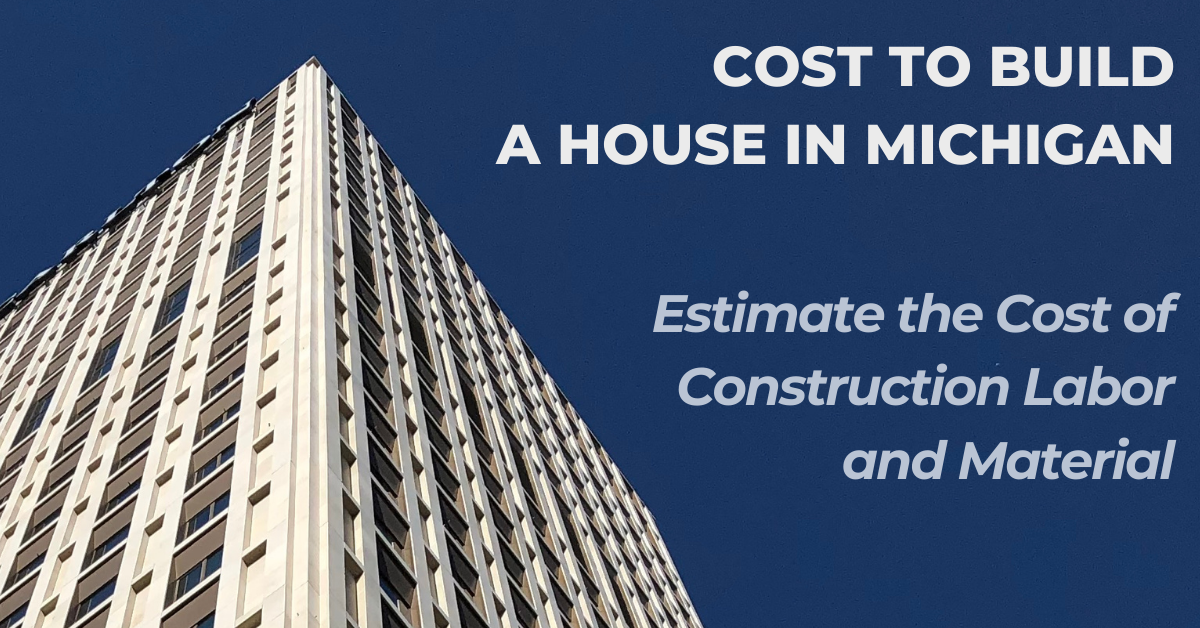The most time-consuming part of any construction business is estimating the projects. We tell you how Cost to Build a House in Michigan.
The truth is if we want to stay in business, we have to consistently estimate projects, but it’s the part that is MOST NEGLECTED.
TIME IS THE ENEMY….
We’re busy going to jobsite meetings, ordering materials, coordinating the team, and a million other things. Who has time to estimate?
That being said, there are THREE methods to estimating projects accurately and FAST.
The Problem with the “Traditional Way” of estimating
The truth is contractors really don’t have time to focus on estimating because construction takeoffs and estimating are typically extremely time-consuming.
Remember….. we are in a numbers game. There are a ton of things you can do to improve your success rate, but at the end of the day, the more jobs you bid, the more chances you have of actually winning work.
Most Contractors will estimate one of two ways:
They’ll send the plans to their Subcontractors on their Master Bid list and hope they get back accurate pricing in a timely mannerThey’ll sit at the kitchen table estimating the job by hand instead of using a good construction estimating software. Sometimes they’ll prepare a material list and send it to their Pieceworkers and Suppliers to get quotes.
The problem with this is it’s too slow and you DEPEND way too much on your Subcontractors, Pieceworkers, and Vendors for pricing, instead of relying on a trusty estimating department.
Subcontractors are typically extremely busy and are usually the ones doing the actual work in the field. So they are literally estimating nights and weekends. How accurate do you think these guys can actually be?
If you’re a GC, do you really want to entrust the success of you landing a job by trusting your Subs number? Imagine if your framing number is too high and you lose the jobs because of that ONE SUB? Most GCs I work with send off their estimates to subs to get pricing and don’t know how to estimate construction projects.
It happens all the time.
The 3 Strategies:
So…… here are the 3 strategies that are going to get you the best results.
If you really want to speed up your estimating and be more accurate, you need to start doing your estimates using the Unit Price Method.
I bet you’re already using Unit Pricing for some of your estimates.
For example, if you’re a painter, and you know you charge $1.00/SF for painting, that’s a unit price.
Most contractors know their pricing but don’t really know their actual direct costs.
The first stage of every estimate is performing a digital takeoff. We use Planswift here in our office, but you can use Bluebeam, OnCenter, and several others. Please, do not estimate by hand. If you are printing the plans and using a scale and highlighter, please invest in digital software. It’s going to be much more accurate and faster to measure quantities.
Next, we use Unit Pricing to figure out our Direct Labor and Material Cost FIRST and then later add Supervision, Overhead, and Profit, and Submarkups if we’re working with Subcontractors.Doing it this way allows you to see your actual costs versus “the way you’ve always done it”. It lets you be more competitive with your numbers and lets you negotiate much better.
I always say when you submit a bid, it’s more of a “Preliminary Bid” since your client always asks for a discount or says your competitor is “cheaper than you”.
Imagine if you can easily see all of your costs on your “Dashboard”. You can see what all your costs are so you can easily make your adjustments during the negotiation phase.
That’s why we encourage our clients to submit as many bids as possible so you can start getting the feedback from your clients. This will ultimately lead you to learn how to win construction bids.
It’s the Ready, Fire, Aim concept. That’s a business term that basically means get your bid our there as fast as possible and “aim” and adjust your pricing based on your client’s feedback.
How to Use Unit Pricing in Your Estimates
As a construction estimator, I highly recommend you invest in a cost database like National Construction Estimator from Craftsman-Books or RS Means.
Companies like Craftsman-Books have a team of researchers and consultants that prepare pricing for thousands of construction assemblies and update their pricing frequently.
In our office, we use National Construction Estimator Database as a starting point. This gives us average costs plus allows you to modify the pricing based on your zip code. We then make adjustments based on field conditions of the projects.
For example, if a wall is 15’ high and requires a Scissor Lift, we’ll adjust the labor and production rates since it’ll be slower production.
Or you can create your own.
For example, if you’re a framing contractor, normally you’d spend a million hours figuring out your materials and then send it out to your supplier. Then you “guess” the labor manually by saying “5 guys x 4 weeks”, etc….
And then you have to do that over and over for all your different wall types, ceilings, posts, beams, etc.
This is extremely time-consuming and inefficient. You also have to add costs to “cushion” your number because you can’t trust it.
What if you spend ONE hour and figure out your actual unit prices so you can bid faster and more accurately?
How to Calculate Your Own Unit Pricing
Step 1 – Take a sample item and calculate your total labor costs and material costs separately.
Step 2 – Divide the costs by total square footage of your sample. Here’s the formula:
Labor Cost / Square Footage = Cost per SF for Labor
Step 3 – Add to your database
Step 4 – Repeat for Material…
Here’s an actual example. I drew up a sketch of a wall. If we were going to figure out our cost per SF for metal framing this wall, this is how I would do it. Step 1 – Take a sample item and calculate your total labor costs and material costs separately.
In this example we have a wall that’s 100 LF x 10’ high with studs at 16” OC.
Labor Cost: 2 guys x 6 hrs x $30/Hr = $360.00
Materials:
-200 LF Track x $0.41/LF = $72.00
-76 Studs x 10’ x $0.42/LF = $319.20
-Pins: 50 Pins x $0.08 EA = $4.00
-7/16” Screws: 304 Screws x $0.01 = $3.04
Total for Materials: $398.24 + 7% Sales Tax = $426.12
Total Direct Costs: $786.12
$786.12 / 1,000 SF = $0.79/SF
So now moving forward we can confidently say to frame a wall will cost us $0.79/SF. We then add about 10% for waste and productivity. Once we estimate the entire project, we can add the duration and calculate things like Supervision, Profit, Overhead, Equipment, etc.
And the last step to this is to do this for each type of item.

If you’re a Subcontractor, you probably have a handful of items you have to create.
If you’re a General Contractor, you really should invest in one of the Cost Databases and build out your template. It’ll take you too long to build your own.
One of the most powerful methods for construction is using what we call The Budget Method.
It has two strategic uses:
1 – As Prospecting Tool
2 – As a last minute Bidding Tool Square Foot Method for Prospecting
One of the strategies we teach is prospecting during the conceptual stage of projects to get your foot in the door with Architects.
Architects don’t ever know what anything costs. For us in the construction…. That’s a great thing.
Architects always design over budget and have to go back and redo a bunch of work usually for free.
As a General Contractor, if you walk into an Architect’s office and say “Hi, I’m interested in working with you. I can provide budget pricing for your projects in the design phase for free.”
Most Architects would instantly partner up with you and start recommending you. The Square Foot Method for Last Minute Bidding
There are times that you’ll get a last minute opportunity to bid a jobs for a GC or Architect and you simply don’t’ have the time to estimate it in detail.
Remember earlier when I mentioned that the first estimate you submit is a “Preliminary Bid”?
Since we already know they are going to ask us for a discount or to lower our price, we can price a little higher which means we don’t need to be so accurate with our first number.
Imagine if you can submit a “Budget” bid. Think of it like a hook. If they bite and they start discussing pricing and scope of work, not you have a potential real project in your hands and you can spend the time to invest in preparing final costs.
If you spend 16 hours preparing an estimate, and they say “Thank you but we went with someone else…” that sucks. Or you can spend 1 hour and you have equal chances of landing the job……. And in the same amount of time you send 15 more bids.

And if this is a numbers game, out of 16 bids, you’ll land about 2-4 jobs.
Strategy #3 – The Rule of Two Method
The final strategy I’m going to share with you is called the Rule of Two Method.
Remember earlier when I mentioned construction costs are about 50% labor?
If you’ve been in business for long, you probably have a great idea of how much labor things take without needing to use a cost database.
Most Contractors I know labor pricing by “3 guys x 5 days”. And piece the project together that way. You get to know that working in the field.
Knowing that labor is about 50% of the costs, if we can calculate a rough idea of our labor cost, we simply just have to multiply that number by 2 and add 10% as a cushion.
One of the best things I ever did in my career was spend time working as a Project Superintendent. I was the guy that coordinated the field activities which oftentimes required me to estimate durations.
As an estimator, knowing how long things take is one of the most strategically important skill you can have.
Even when we are performing estimates, oftentimes we have to adjust pricing for difficult working conditions, field conditions, custom items, complexities, etc. And there’s simply no way to get those numbers from a database.
We might start our pricing using the database, but we adjust based on the location, the conditions of the jobs, the difficulty of the assembly, etc.
CONCLUSION:
Most contractors miss out on projects because they are so busy running their companies that they neglect estimating.
Part of the reason is that they estimate the Traditional Way which typically takes much longer and is less accurate.
If you’re interested in finding our more information, click here to learn more about our estimating services page.

